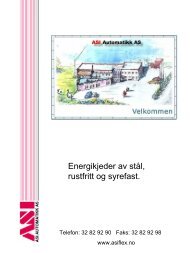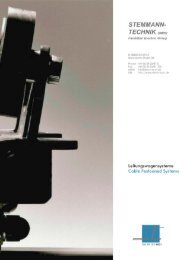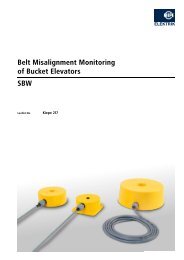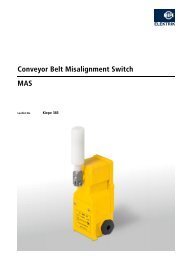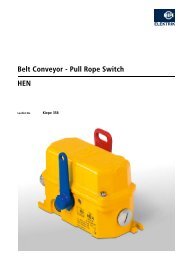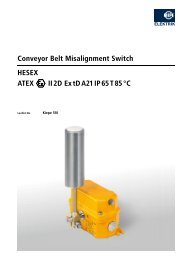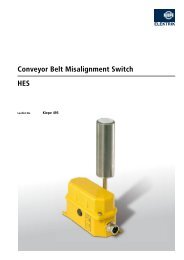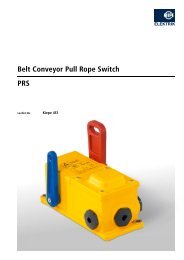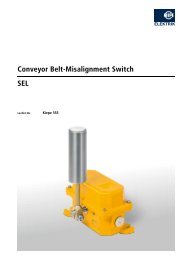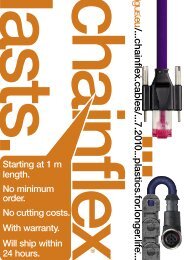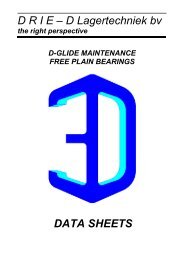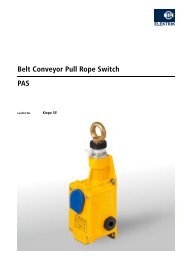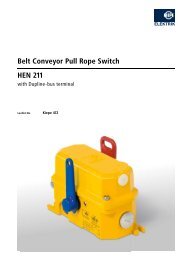DryLin linear guides - ASI Automatikk
DryLin linear guides - ASI Automatikk
DryLin linear guides - ASI Automatikk
Create successful ePaper yourself
Turn your PDF publications into a flip-book with our unique Google optimized e-Paper software.
<strong>DryLin</strong> ®<br />
<strong>DryLin</strong> ® – Technical Information<br />
<strong>DryLin</strong> ® – Technical Information<br />
<strong>DryLin</strong> ®<br />
Phone +49- (0) 22 03-96 49-145<br />
<strong>DryLin</strong> ®<br />
Fax +49- (0) 22 03-96 49-334<br />
igus ® GmbH<br />
51127 Cologne<br />
Internet: www.igus.de<br />
E-mail: info@igus.de<br />
Coefficients of friction [µ]<br />
Coefficient of friction [µ]<br />
Wear in [µm/km]<br />
Wear in [µm/km]<br />
Graph 242.1: Coefficient of friction as a function<br />
of the speed/<strong>DryLin</strong> ® R p = 0.9 MPa<br />
0,2 0,2<br />
0,15 0,15<br />
0,1 0,1<br />
0,05 0,05<br />
0 0<br />
0,15 0,3 0,6 1 ,2 2<br />
v [m/s]<br />
Graph 242.2: Coefficient of friction as a function<br />
of the speed/ <strong>DryLin</strong> ® T, p = 0.46 MPa<br />
0,170<br />
0,165<br />
0,160<br />
0,155<br />
0,150<br />
0,145<br />
0,15 0,3 0,6 1,2<br />
1,2 1,2<br />
1,0 1,0<br />
0,8 0,8<br />
0,6 0,6<br />
0,4 0,4<br />
0,2 0,2<br />
0 0<br />
0,8 0,8<br />
0,6 0,6<br />
0,4 0,4<br />
0,2 0,2<br />
v [m/s]<br />
Graph 242.3: Wear in µm/km for different sliding surface,<br />
p = 1 MPa<br />
iglidur ® J<br />
<strong>DryLin</strong> T<br />
iglidur ® J<br />
aluminum shaft<br />
iglidur ® J<br />
cold rolled steel<br />
iglidur ® J<br />
stainless steel<br />
iglidur ® X<br />
aluminum shaft<br />
Graph 242.4: Load dependent wear in µm/km<br />
iglidur ® X<br />
cold rolled steel<br />
iglidur ® X<br />
stainless steel<br />
0 0<br />
0,05 0,1 0,25 0,5 1<br />
Surface load [MPa]<br />
<strong>linear</strong> guide systems have clear advantages in applications with high<br />
amounts of dirt, the coefficients of friction in dirty applications also<br />
increase. It was observed that the stability of the coefficients of friction<br />
after start up is not always present in extreme application conditions.<br />
Wear behaviour<br />
The wear behaviour of <strong>DryLin</strong> ® is a function of the shaft material, but<br />
it works well on many different materials. The surface load, in addition<br />
to the shaft material and roughness, has an effect on the wear. With<br />
decreasing surface load, the wear also decreases in µm/km.<br />
Stick slip behaviour<br />
<strong>DryLin</strong> ® is very resistant to the behaviour known as stick slip. Stick<br />
slip occurs when there is intermittent movement between two sliding<br />
surfaces. The stop and go movement is caused by frequent changes<br />
from static to dynamic friction. The coefficients of static and dynamic<br />
friction are close enough to each other for iglidur ® J so that the danger<br />
of stick slip behaviour is very low.<br />
Operating temperatures<br />
Sliding elements made of iglidur ® J and J200 can be used in the<br />
temperature range between -40 and +90°C. Due to of the excellent<br />
thermal conductivity of aluminum as a shaft and housing material, a<br />
large increase in bearing temperature only occurs in high frequency,<br />
short stroke applications with a high load.<br />
iglidur ® X is recommended for temperatures up to 250°C, and is offered<br />
in <strong>DryLin</strong> ® R in combination with hardened, chrome plated or stainless<br />
steel shafts.<br />
Shaft materials<br />
The maintenance free <strong>linear</strong> plain bearings can be combined with<br />
many different shaft materials. In addition to the various steels, other<br />
materials such as carbon fibre and ceramics are possible. The best<br />
friction and wear properties are obtained for shaft roughnesses of<br />
Ra = 0.1 – 0.3 µm. Rougher surfaces lead to increased wear, especially<br />
during the start up phase.<br />
Table 242.1: Suitability of different shaft materials<br />
Shaft material<br />
Suitability<br />
Hardened, ground steel shafts<br />
Hardened, ground stainless steel shafts<br />
hard anodized or anodized aluminum shafts<br />
Free cutting steel<br />
Ceramic<br />
GFK and CFK shafts<br />
HR Carbon steel<br />
303 Stainless steel/304 stainless steel<br />
Chemical resistance<br />
Eccentric forces<br />
<strong>DryLin</strong> ® <strong>linear</strong> bearings are resistant to weak acids, diluted Alkalines For the successful use of the maintenance free <strong>DryLin</strong> ® R <strong>linear</strong> bearings,<br />
and to fuels and all types of lubricants. Even the frequent chemical a few design rules must be considered. Due to the higher coefficient<br />
washdowns of machines in the food industry are not a problem. of friction in comparison to ball bearing <strong>guides</strong>, a higher driving force<br />
The chemical resistance of a <strong>linear</strong> bearing system is also dependent is necessary.<br />
on the shaft material. For a system that is resistant to chemicals, a<br />
high alloy stainless steel would be suitable, for example, 440 stainless<br />
steel, especially when used with iglidur ® X as a bearing material.<br />
Corrosion behaviour<br />
The low moisture absorption of <strong>DryLin</strong> ® bearings allows design in<br />
underwater applications. With the use of stainless steel or anodized<br />
aluminum shafts, a corrosion resistant system is achieved. Anodized<br />
aluminum is resistant to chemically neutral materials in the PH range<br />
2 to 7. For special applications it is recommended to test anodized<br />
aluminum sample parts to examine results prior to their use.<br />
Quiet operation<br />
Sliding elements made of polymers, which run on ground shafts or<br />
profile rails, are extremely quiet running, as opposed to the traditional<br />
ball <strong>guides</strong> where the noise level increases with speed.<br />
Permissible speeds<br />
Because of the structure of the <strong>DryLin</strong> ® <strong>linear</strong> plain bearings (rolling parts<br />
are eliminated) extremely high speeds (more than 15 m/s) and accelerations<br />
(200 m/s 2 ) can be achieved. <strong>DryLin</strong> ® bearings are thus suitable for<br />
applications where acceleration and cycle times need to be increased.<br />
The permissible average surface speed depends on the bearing load.<br />
With decreasing surface load, higher speeds can be obtained. More<br />
significant than the maximum speed is the average speed per cycle,<br />
since the temperature of the bearing system is more greatly affected. To<br />
calculate the suitability of the <strong>linear</strong> bearing systems, the average surface<br />
speed should be determined. In applications with intermittent cycles, the<br />
highest average surface speed is significant.This is an average taken<br />
over a time period of 10 to 30 minutes. The use of hard anodized aluminum<br />
as the running surface lowers the operating temperature at the bearing<br />
surface due to the thermal conductivity of the aluminum. Thus, even for<br />
very short stroke lengths, the system can be driven at a high frequency.<br />
The 2:1 rule<br />
2 x<br />
1x<br />
When using <strong>linear</strong> plain bearings, the 2:1 rule (see drawing above)<br />
must be observed. If not, a non uniform movement, or even a binding<br />
of the system occurs. Often an application can be solved by relatively<br />
simple changes. The principle is not a function of the load or the driving<br />
force – it is a product of the friction and always relates to the fixed<br />
bearing. The further the drive is located from the guide bearing, the<br />
greater the wear and necessary drive forces. If the distance of the<br />
driving force to the fixed bearing is more than double the distance<br />
between the bearings (2:1 Rule), the system will in theory bind at a<br />
coefficient of static friction of 0.25. Our application consultants will be<br />
glad to help you in creating a design that is suitable for the plain bearing.<br />
Please send us a drawing, in which:<br />
The distance between the rails,<br />
The distance between the carriages,<br />
And the distances and applied loads [N] of the acting forces<br />
are shown.<br />
With this information we will advise on system function, required driving<br />
force, and the expected bearing lifetime in your application.<br />
Table 539.1: Chemical resistance of iglidur ® J, iglidur ® J200, iglidur ® X<br />
Medium iglidur ® J iglidur ® J200 iglidur ® X<br />
Alcohol Resistant Resistant Resistant<br />
Chlorinated hydrocarbons Resistant Conditionally Resistant Resistant<br />
Ester Not Resistant Not Resistant Resistant<br />
Greases, oils Resistant Resistant Resistant<br />
Ketones Conditionally Resistant Conditionally Resistant Resistant<br />
Fuels Resistant Resistant Resistant<br />
Weak acids Conditionally Resistant Conditionally Resistant Resistant<br />
Strong acids Not Resistant Not Resistant Conditionally Resistant<br />
Weak Alkalines Resistant Resistant Resistant<br />
Strong Alkalines Resistant Resistant Conditionally Resistant<br />
Sea water Resistant Resistant Resistant<br />
For further details see the chemical resistance table on page 115<br />
Phone +49- (0) 22 03-96 49-145<br />
<strong>DryLin</strong> ®<br />
Fax +49- (0) 22 03-96 49-334<br />
mm<br />
242<br />
Lifetime calculation, CAD files and much more support www.igus.de/en/<strong>DryLin</strong> Lifetime calculation, CAD files and much more support www.igus.de/en/<strong>DryLin</strong><br />
243



